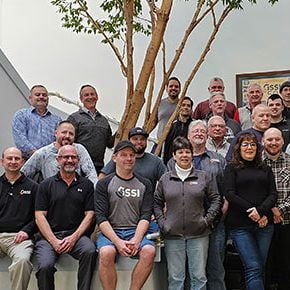Orange Box Blog #1: An Overview of Normal and Cross-Polarized GPR Antennas for Concrete Scanning
We are all familiar with the classic hyperbolic targets that are the hallmark of GPR data. In concrete, they represent discrete objects like rebar, conduit, and strands of wire mesh. Metallic objects generate bright and wide hyperbolas and lend themselves to straightforward interpretation. What you might not realize is that most ground-penetrating radar antennas are designed to optimize the imaging of these and other metal targets, based on the alignment of the antenna elements. Each GPR antenna combines a transmitter that ‘talks’ and a receiver that ‘listens’. In the standard configuration, often termed normal polarization (Figure 1), the antenna’s transmitter and receiver are aligned parallel to each other, perpendicular to the path of travel, and are oriented parallel to linear metallic objects. Under most conditions, normally polarized antennas capitalize on the electromagnetic properties of the GPR energy and the response of rebar and other reinforcement. In other words, normal polarized antennas are ideal for locating metal targets.

Figure 1. Normal polarization, where the transmitter and receiver are aligned perpendicular to the path of travel.
Most concrete markouts benefit from these engineering and physics principles, but in complex settings there are some critical problems. To understand the underlying issues it is important to understand how the GPR energy travels through a solid medium, like concrete, and why normal polarization is not the best choice for all conditions. It is tempting to think that the GPR wave behaves like a flashlight beam. That is, illuminating a circular area that expands as the beam travels farther away. In reality, GPR energy radiates in an expanding cone that is closer to a NFL football-like ellipse. Figure 2 demonstrates this concept. With normal polarization, the GPR energy illuminates an elliptical area that is wide from front-to-back (an approximate 90-degree angle) and narrow from side-to-side (a roughly 45-degree angle). As the GPR energy travels farther from the antenna (deeper) the illuminated footprint becomes a progressively larger ellipse. Since the illuminated area is wide in the direction of travel the GPR energy reflects off targets in front of, below, and behind the GPR antenna. It is this GPR behavior that creates the classic bright and wide hyperbolas that we know and love. The problem is that those glorious hyperbolic tails extend across the GPR profile and can merge closely spaced targets, while also extending deeper into the profile obscuring and sometimes obliterating underlying targets and the slab/grade contact. Moreover, normal polarization enhances metallic targets at the expense of non-metallic targets such as PVC pipes. Certain real-time techniques, like Focus Mode, and post-processing methods, like Migration, could reduce the impact of expansive hyperbolic tails. However, reversing the metal-enhancing polarization effect is not possible.

Herein lies the critical issue. Dense reinforcement is common in concrete slabs, and if the resulting hyperbolas overshadow non-metallic targets and obscure deeper slab elements we have to wonder what we are missing. In these and other situations, we must rely on cross-polarization to extract more information from the GPR data. In academic literature, cross-polarization indicates that the antenna elements are aligned at different angles relative to each other (Figure 3). For instance, this could include a transmitter with a receiver perpendicular to its long axis and vice versa. This configuration is rarely used in industry, as it is not optimal for conventional scanning. Instead, we can simply turn our antenna 90-degrees and collect another scan that provides different but complimentary information. To separate antenna rotation from academic cross-polarization, in this discussion I will coin the term Commercial Cross-Polarization, which I define as a simple change in antenna housing orientation (90-degrees to right or left) relative to the path of travel (Figure 2, Figure 3). This does not refer to a fundamental change in relative transmitter and receiver alignment because commercial GPR systems use fixed antenna geometry. Using commercial cross-polarization, in forward movement the transmitter and receiver are now parallel to the line of travel as opposed to perpendicular to line of travel with normal polarization.

Figure 3. Comparison of GPR antenna configurations using normal polarization, commercial cross-polarization, and an example of the academic definition of cross-polarization.
Comparing normal polarization and commercial cross-polarization scans will show significant differences. Turning the antenna 90-degrees changes the direction of the elliptical illuminated area (Figure 2). Remember the wide-front-to-back pattern of normal polarization? When the antenna is turned 90-degrees the ellipse is also rotated. Now the illuminated area is much narrower from front-to-back, resulting in less expansive hyperbolas. In some cases the reinforcement-generated hyperbolas will be absent, leaving just the targets below. Gone are the sword fighting hyperbolic tails that hide deeper targets and layers such as air voids. Additionally, the remaining metal-derived hyperbolas will not be as strong as their normal polarized counterparts and weaker targets (like PVC pipes) will be easier to spot.
Let’s consider a classic concrete scenario, where heavy reinforcement creates a congested GPR profile. Using normal polarization, we’ll illuminate a wide elliptical footprint extending ahead of and behind the antenna. Linear metal targets approached perpendicular to their long axis will respond well to this polarization, resulting in bright targets with large hyperbolic tails. In normal polarization (Figure 4, left), there are abundant well-defined targets but they are closely spaced and almost overlapping in a few places. The hyperbolic tails are cutting across the profile and it is unclear if: 1) there are targets below the obvious ones; 2) there are side-by-side targets merged into a single hyperbola; or 3) there is voiding or other concerns at the base of the slab. As safety is our primary concern, we should try commercial cross-polarization to see what else is hiding in the concrete. It’s quick, easy, and could show something we might have missed. Why not?

Figure 4. A normal polarization profile (top) and a cross-polarization profile (bottom) collected across the same transect.
Using a GSSI Palm-style antenna, like the PalmXT accessory for the StructureScan MiniXT, we can turn the antenna 90-degrees and rotate the encoder wheel. No need to power down the system, and you don’t even have to start a new file (unless you want to). Passing the antenna over the same track as before, we see a totally different view of the slab contents. The most obvious change is that there are hardly any visible hyperbolas (Figure 4, right). We can see some complex locations where two targets are closely spaced and the hyperbolas didn’t completely disappear. I suspect these targets were crossed at some angle other than 90-degrees; maybe 45-degrees or so. Additional profiles to either side would solve that mystery. Two other interesting features are now visible, each of them a continuous layer that was chopped up in the normal polarized example and nearly undetectable. The layer at 4-inches deep is an artifact of the cross-polarized data and represents closely spaced reinforcement. Additionally, we can see the base of the slab!
Figure 5 shows another comparison. The left profile was collected using normal polarization. The shallow targets are quite obvious, but a close inspection shows that something might be hiding below the mesh. The right profile shows the cross-polarized data, with a now visible target. Notice how the hyperbolas from the metallic reinforcement are much weaker, and the lower target is stronger than before? That’s commercial cross-polarization in a nutshell.

Figure 5. A normal polarization profile (top) and a cross-polarization profile (bottom) collected across the same transect.
Closing Remarks
I hope this post illuminated the subject of antenna polarization and made the concept more accessible. In most concrete scanning situations, using a combination of normal and commercial cross-polarized orientations is the best way to see everything that GPR can show you. I recommend letting normal polarization do most of the heavy lifting, and using cross-polarization to look for more subtle and non-metallic targets that might otherwise be missed. As with most concepts in geophysics, a short and simple explanation is not possible (or adequate). I therefore briefly covered several interrelated concepts, though in the interest of brevity I left out a few things here and there and you probably have questions. Feel free to contact us for more information!
Do you currently employ commercial cross-polarization when scanning concrete? If so, how do you use it? Feel free to comment on this or other topics.
Key Takeaway Points:
- For concrete scanning with GPR, there is more than one way to skin a cat. It is important to have a few tricks up your sleeve when the going gets tough.
- GPR energy does not behave like a circular flashlight beam. The GPR energy travels as an ellipse that expands with increasing depth. Normal polarization illuminates an elliptical area that is wide from front to back, while the elliptical footprint generated by commercial cross-polarization is narrow from front to back.
- Normal polarization, in simple concrete environments, quickly highlights metallic targets for a clean markout. This is the standard scanning method, but dangers (and non-metallic targets) could be hiding deeper in the slab.
- Using commercial cross-polarization in complex concrete settings, where reinforcement is dense and other targets are expected within and below the slab, is a powerful way to visualize the data differently. This method can capitalize on the polarity response from non-metallic targets and downplay the influence of metallic targets, the illuminated footprint is smaller front-to-back, hyperbolas are less expansive, and targets and continuous layers below reinforcement are clearer and easier to interpret.
- Most of GSSI’s concrete scanning GPR products are cross-polarization capable either though antenna reorientation or attaching accessory antennas. If you use GSSI products, you probably already have cross-polarization capability!



